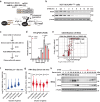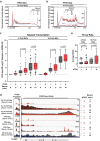KAP1 negatively regulates RNA polymerase II elongation kinetics to activate signal-induced transcription
- PMID: 38997286
- PMCID: PMC11245487
- DOI: 10.1038/s41467-024-49905-7
KAP1 negatively regulates RNA polymerase II elongation kinetics to activate signal-induced transcription
Abstract
Signal-induced transcriptional programs regulate critical biological processes through the precise spatiotemporal activation of Immediate Early Genes (IEGs); however, the mechanisms of transcription induction remain poorly understood. By combining an acute depletion system with several genomics approaches to interrogate synchronized, temporal transcription, we reveal that KAP1/TRIM28 is a first responder that fulfills the temporal and heightened transcriptional demand of IEGs. Acute KAP1 loss triggers an increase in RNA polymerase II elongation kinetics during early stimulation time points. This elongation defect derails the normal progression through the transcriptional cycle during late stimulation time points, ultimately leading to decreased recruitment of the transcription apparatus for re-initiation thereby dampening IEGs transcriptional output. Collectively, KAP1 plays a counterintuitive role by negatively regulating transcription elongation to support full activation across multiple transcription cycles of genes critical for cell physiology and organismal functions.
© 2024. The Author(s).
Conflict of interest statement
The authors declare no competing interests.
Figures






Update of
-
KAP1 negatively regulates RNA polymerase II elongation kinetics to activate signal-induced transcription.bioRxiv [Preprint]. 2024 May 5:2024.05.05.592422. doi: 10.1101/2024.05.05.592422. bioRxiv. 2024. Update in: Nat Commun. 2024 Jul 12;15(1):5859. doi: 10.1038/s41467-024-49905-7. PMID: 38746145 Free PMC article. Updated. Preprint.
Similar articles
-
KAP1 negatively regulates RNA polymerase II elongation kinetics to activate signal-induced transcription.bioRxiv [Preprint]. 2024 May 5:2024.05.05.592422. doi: 10.1101/2024.05.05.592422. bioRxiv. 2024. Update in: Nat Commun. 2024 Jul 12;15(1):5859. doi: 10.1038/s41467-024-49905-7. PMID: 38746145 Free PMC article. Updated. Preprint.
-
KAP1 Is a Chromatin Reader that Couples Steps of RNA Polymerase II Transcription to Sustain Oncogenic Programs.Mol Cell. 2020 Jun 18;78(6):1133-1151.e14. doi: 10.1016/j.molcel.2020.04.024. Epub 2020 May 12. Mol Cell. 2020. PMID: 32402252 Free PMC article.
-
KAP1 targets actively transcribed genomic loci to exert pleomorphic effects on RNA polymerase II activity.Philos Trans R Soc Lond B Biol Sci. 2020 Mar 30;375(1795):20190334. doi: 10.1098/rstb.2019.0334. Epub 2020 Feb 10. Philos Trans R Soc Lond B Biol Sci. 2020. PMID: 32068487 Free PMC article.
-
KAP1/TRIM28: Transcriptional Activator and/or Repressor of Viral and Cellular Programs?Front Cell Infect Microbiol. 2022 Feb 23;12:834636. doi: 10.3389/fcimb.2022.834636. eCollection 2022. Front Cell Infect Microbiol. 2022. PMID: 35281453 Free PMC article. Review.
-
Splitting hares and tortoises: a classification of neuronal immediate early gene transcription based on poised RNA polymerase II.Neuroscience. 2013 Sep 5;247:175-81. doi: 10.1016/j.neuroscience.2013.04.064. Epub 2013 May 24. Neuroscience. 2013. PMID: 23711585 Free PMC article. Review.
Cited by
-
Functional Analysis of KAP1/TRIM28 Requirements for HIV-1 Transcription Activation.Viruses. 2024 Jan 13;16(1):116. doi: 10.3390/v16010116. Viruses. 2024. PMID: 38257816 Free PMC article.
-
The HIV-1 Transcriptional Program: From Initiation to Elongation Control.J Mol Biol. 2025 Jan 1;437(1):168690. doi: 10.1016/j.jmb.2024.168690. Epub 2024 Jun 25. J Mol Biol. 2025. PMID: 38936695 Free PMC article. Review.
References
MeSH terms
Substances
Grants and funding
- R03 CA259672/CA/NCI NIH HHS/United States
- F99CA264296/U.S. Department of Health & Human Services | NIH | National Cancer Institute (NCI)
- R01 AI114362/AI/NIAID NIH HHS/United States
- P30 CA142543/CA/NCI NIH HHS/United States
- P50 CA196516/CA/NCI NIH HHS/United States
- P50 CA070907/CA/NCI NIH HHS/United States
- F99 CA264296/CA/NCI NIH HHS/United States
- R01 DK058110/DK/NIDDK NIH HHS/United States
- R01DK058110/U.S. Department of Health & Human Services | NIH | National Institute of Diabetes and Digestive and Kidney Diseases (National Institute of Diabetes & Digestive & Kidney Diseases)
LinkOut - more resources
Full Text Sources
Molecular Biology Databases
Miscellaneous

